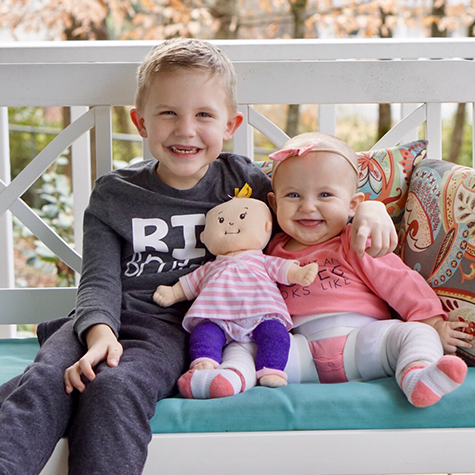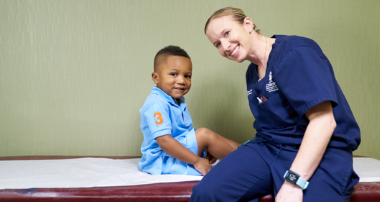Pavlik Harness
A Pavlik harness is prescribed for some pediatric patients who are diagnosed with an injury to their femur (thigh bone) or developmental dysplasia of the hip (DDH), also known as hip dysplasia. It is specially designed to gently position your baby’s hips so they are aligned in the joint and to keep the hip joint secure.
Hip dysplasia can be present at birth or develop as your child grows. It describes a wide range of problems, such as a misshapen joint ball or socket, or a loose hip joint. It occurs in 1 in 1,000 births and can run in families or be caused by something in the baby’s environment in the mother’s womb.
A Pavlik harness, which may be prescribed when babies are younger than 6 months old, helps:
- Keep your baby’s legs and hips in place while allowing some movement.
- Keep your baby’s legs flexed up with his knees pointing out.
- Hold a broken femur in position while it heals.
It is a soft fabric brace that has three main parts:
- Shoulder straps
- A band that wraps around your baby’s chest
- Connecting straps that keep the legs and hips in the proper position
How long will my baby wear the Pavlik harness?
Your baby’s care team, including the doctor, physician assistant, orthotist and cast technician, is trained to fit the harness properly and will manage his care. It is very important to use the brace as instructed.
The Pavlik harness will be worn for 24 hours a day. Pediatric patients with hip dysplasia will wear the harness for six to 12 weeks, while babies with a femur fracture will wear it for three to four weeks.
It is important that parents and caregivers never remove the Pavlik harness unless advised by their baby’s doctor. Both of the baby’s legs must remain in the harness at all times, even if there is a problem with just one side.

Quinn’s journey with hip dysplasia and a spica cast
Quinn was diagnosed with developmental dysplasia of the hip (DDH), also known as hip dysplasia. Our team of specialists helped correct her hips through surgery, casting and bracing.
Read Her StoryDressing your baby in a Pavlik harness
Dress your baby in loose clothing that can be changed without removing the harness. You may leave the harness on over bare skin and dress your child over the harness. If your baby wears a T-shirt or other clothing under the harness, only remove one strap at a time when changing clothes. This will help keep your baby’s legs in the proper position. Make sure your baby’s diapers are fastened underneath the harness.
Bathing your baby in a Pavlik harness
During bath time, it is important to follow these rules:
- Do not remove the harness when bathing your child.
- Give your baby sponge baths instead of regular baths. This will help keep the harness dry.
- Clean all of your baby’s skin folds and creases to make sure there is no chafing or rubbing on his legs.
- Dry your baby’s skin very well after a bath.
- Check your baby’s skin every day for redness, chafing or rashes. Check the skin folds behind his knees and in the diaper area for irritation.
- Keep the harness as dry as possible. Towel dry the harness if it gets wet.
- If the harness gets dirty:
- Do not remove it.
- Gently spot clean the harness with mild soap and water.
- Dry it with a towel.
These are some general rules to follow while your baby is wearing a Pavlik harness:
- Make sure he sleeps on his back and is able to turn his head to each side.
- Make sure he has regular playtime.
- Use a car seat but try to limit the amount of time he is in it.
- Place your baby with his tummy on your tummy and his legs out to either side of your body when breastfeeding.
- Always try to keep his knees pointing outward, and avoid any contact to the outside of the legs that may push the knees inward when you are holding your baby or he is lying down.
- Do not place him on his side.
- Do not hold him in a “standing position.”
- Do not adjust the harness yourself; only your baby’s care team should adjust the harness during regular appointments.
- Do not swaddle him; swaddling could press his legs together when they need to remain apart.
- Do not let your baby have tummy time unless a pillow is put under his tummy and chest.
- Avoid long car journeys when possible to avoid the legs being pushed together. Use a regular car seat for short trips or purchase car seats with lower sides that allow for a wider position.
- Use a front-facing carrier if you choose to wear your baby in a carrier. Baby carriers should support the entire thigh with the legs apart. Avoid bay-wearing slings because the legs can dangle together.
When your child is wearing a Pavlik harness, you should:
- Avoid lifting him by his legs or feet.
- Avoid using bumpers or rollers around the legs. This may limit the outward movement of the hips, which is needed for proper growth.
- Avoid using a baby sling or carriers that limit the outward movement of the hips.
- Avoid carrying your baby with his knees pressed together. Hold him so his legs are able to move outward.
- Avoid putting him in walkers or bounces for six months after treatment, unless advised by your care team.
When should I call my baby’s doctor?
We suggest calling your baby’s doctor if you have any questions about how your child looks or feels in the harness or if you have concerns about how the harness is fitting.
Call your doctor or orthotist right away if your baby:
- Is so fussy or irritable you cannot comfort him.
- Stops kicking or moving one leg.
- Has areas of skin that become very red.
- Has a rash.
- Has swelling around his toes.
- Has a fever higher than 101.5°F.
While wearing the harness, your child will need to see the doctor every one to two weeks for routine follow-up care.
Support on Facebook
This content is general information and is not specific medical advice. Always consult with a doctor or healthcare provider if you have any questions or concerns about the health of a child. In case of an urgent concern or emergency, call 911 or go to the nearest emergency department right away. Some physicians and affiliated healthcare professionals on the Children’s Healthcare of Atlanta team are independent providers and are not our employees.
Contact Us 404-255-1933

